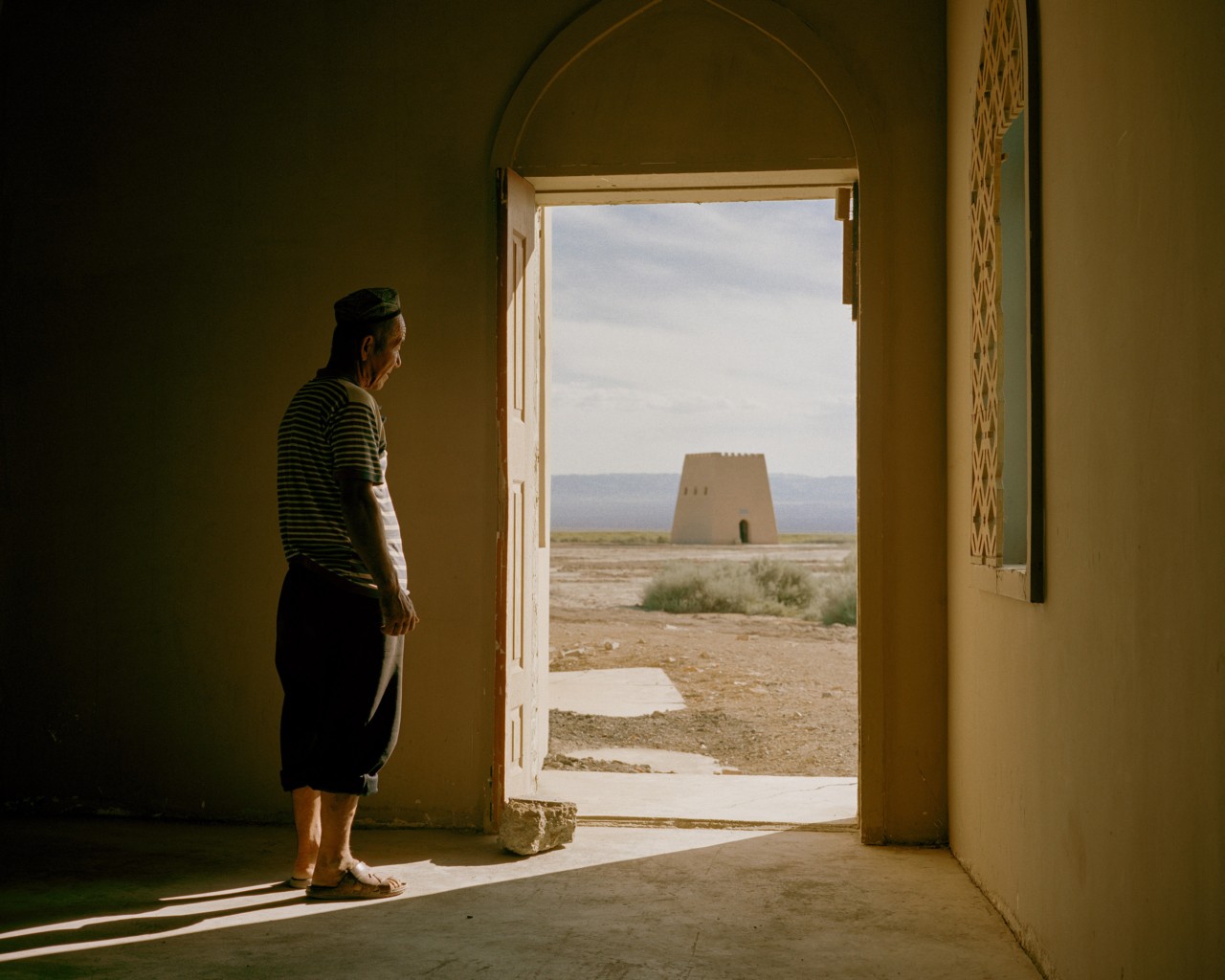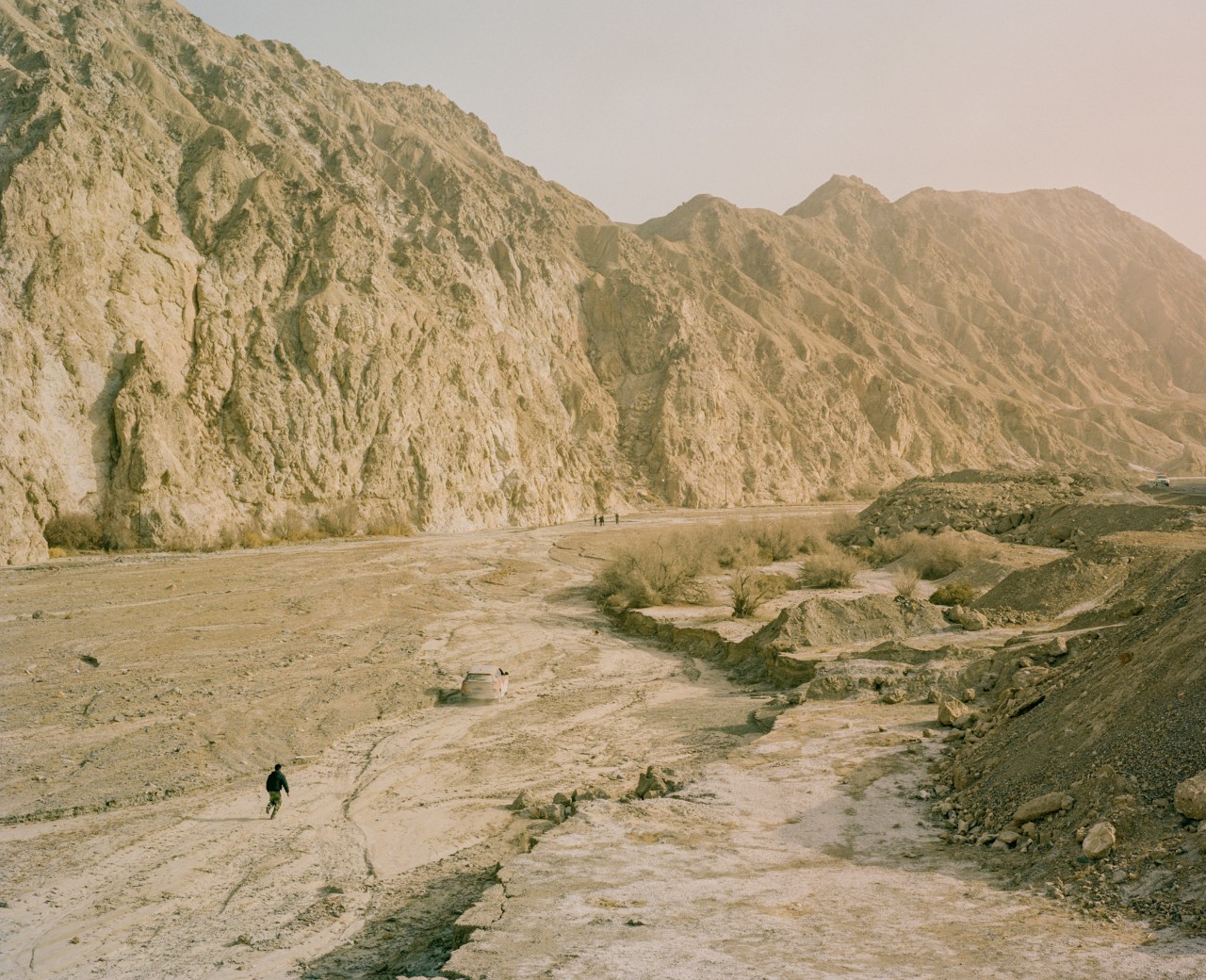

WORDS BY NITHIN COCA
Photographs by Patrick Wack
In June, the world’s largest solar plant opened in China—a 3.5 gigawatt (GW) behemoth. Covering 32,947 acres, it can produce enough energy alone to power Luxembourg. News sites and pro-solar groups hailed the project as a milestone, showcasing the country’s leadership in renewable energy and adding to a growing consensus that China could peak emissions ahead of schedule.
Nearly none, though, highlighted one obvious detail: the location of the plant, in the far western regions of Xinjiang, near the regional capital of Ürümqi. It’s the homeland of the Uyghurs, where, since 2018, what many consider a genocide has been taking place.
In fact, the solar plant is just an hour away from where Uyghur-American Rushan Abbas was born and grew up. Now based near Washington, D.C., she has been unable to return home for decades and has had no contact with her family in years.
“By failing to acknowledge the dark realities behind this solar plant near where I was born, raised, and educated, Ürümqi, they are allowing China to present a false narrative,” said Abbas. “This mega-solar plant is a continuation of the broader history of Chinese occupation and exploitation of Uyghurs.”
To Abbas and other Uyghurs living outside of what China calls Xinjiang and what they call East Turkestan, the solar plant doesn’t deserve praise. Rather, it’s the latest in a decades-long effort to Sinicize the region and exploit its resources to benefit Han Chinese migrants. They believe that the state’s flaunting of record-setting solar expansion is part of a broader plan to greenwash the ongoing genocide of Uyghurs and further allow the colonization of their homeland.
“Who will truly benefit from this project?” asked Elfidar Iltebir, a Uyghur-American activist born in Ürümqi and president of the Uyghur-American Association. “How many Han Chinese workers will be transferred to the region, further diluting the Uyghur population? How much Uyghur land, including graveyards and homes, has been repurposed for this solar farm?”
Just because it’s a solar project doesn’t exempt it from the criticisms that plague fossil fuel or infrastructure projects elsewhere.

One reason that the Urumqi project got so much praise is that many climate activists, scientists, and policymakers see an urgent need to build as many solar, wind, and other renewable energy sources as quickly as possible. Projects like a 3.5 GW solar plant, or China adding 216 GW in 2023—more than the entire solar capacity of the entire United States—gives hope.
“This project showed the world that with the significant price drop in solar panels and solar modules, technological innovation can bring solar projects to the next level,” said Xuyang Dong, an energy policy analyst at Climate Energy Finance, an Australian NGO.
Proponents argue that whatever adverse impacts solar production has, it is dwarfed by the negative impacts of fossil fuels. Fossil fuels have devastated not only the climate, but also communities near sites of drilling and mining, which have seen their landscapes ruined, water polluted, and livelihoods impacted. Quite often, they do not reap any benefits from extraction, either.
“This mega-solar plant is a continuation of the broader history of Chinese occupation and exploitation of Uyghurs.”
Here’s the thing—Uyghurs know this well. Shortly after East Turkestan was occupied by the newly-in-power Chinese Communist Party in 1949, Han Chinese migrants, led by the state-owned Xinjiang Production and Construction Corps (XPCC), began flowing into the newly renamed region, seeking to exploit its natural resources: coal, quartz, silicon, and oil.
“When the XPCC first entered our region, they promised development but gradually seized lands and water resources, leaving Uyghur farmers unable to sustain their livelihoods,” said Iltebir. “Many were forced to sell their lands to the XPCC and work for them just to survive.”
To this day, Xinjiang is one of China’s main coal- and oil-producing regions. In fact, coal is what fuels China’s solar industry, which produces panels using subsidized Xinjiang coal.
“Historically my homeland has been rich in resources from cotton to coal to rare earth minerals,” said Abbas. “Since the 1950s, the Chinese government has systematically taken control of these resources to fuel its economic ambitions, while displacing and oppressing the local Uyghur population and migrating Han Chinese from China proper.”
Since the arrival of Han Chinese migrants and corporations, the demographics of the region have transformed entirely. In 1953, Uyghurs were 75% of the population, with Han Chinese at just six percent. Today, Uyghurs make up just 44% of the population, having become a minority in their homeland—a figure that continues to decline as China’s genocidal campaign of forced sterilization, family separation, and cultural “re-education” trudges on.

The $2.13 billion Urumqi plant is, like nearly all of the major fossil fuel, mining, and clean tech projects in the region, led by a Chinese consortium: the state-affiliated China Construction Eighth Engineering Division Corp, PowerChina, and China Green Development Group. In English and Chinese promotional materials, the project proponents highlight its climate impacts—reducing CO2 emissions by 6 million tons and eliminating the demand for 1.9 million tons of coal. Nowhere are benefits to Uyghurs mentioned, and no Uyghur staff or spokespeople are listed in any of the media materials.
“It feels hypocritical to be talking about just transition when this specific just transition is tainted with human rights abuses,” said Zumretay Arkin, an ethnic Uyghur who grew up in Canada and now lives in Germany, and director of global advocacy at the World Uyghur Congress.
The rise of solar is, to Arkin and Abbas, another form of extraction. Instead of minerals, fossil gas, or silicon, solar energy is being harvested on stolen land and exported to western China to power homes and factories in Han-populated regions. It’s the same story, but this time, with a green facade.
“This solar plant is just the latest manifestation of those atrocities,” said Abbas. “China is extracting solar energy resources from the land while continuing its campaign of repression against my people.”
In recent years, there has been greater pushback on the idea that solar or wind is automatically better than other forms of extraction. In addition to plants being sited on or near Indigenous land, the critical minerals required to build renewable energy technologies are extracted from these communities, too.
“Who will truly benefit from this project? How much Uyghur land, including graveyards and homes, has been repurposed for this solar farm?”
A report from the Business and Human Rights Resource Center (BHRRC) found that, broadly, clean energy companies are lagging on human rights policies, including issues like land rights, responsible sourcing, and affected community rights. Chinese companies, including Jinko Solar, Goldwin, LONGi, and JA Solar, were the lowest ranked.
One tool that has been proposed to ensure a just transition is for companies to obtain free, prior, and informed consent, or FPIC. This principle sets clear guidelines to ensure community approval before investing in or building any projects.
“One thing that we believe is going to be critically important is to make sure that projects are codesigned,” said Caroline Avan, the head of natural resources and just energy transition at BHRRC. “So it’s not only about getting their consent but having local people who are actually partners in that project.”
If the Urumqi plant engaged in FPIC, there would have been an opportunity to understand the true impacts of the project: Were jobs going to Han migrants, or Uyghurs? Whose land was it being built on? And was there adequate compensation? But none of that was possible in Xinjiang, due to the state’s role in perpetuating human rights abuses. Instead of FPIC, the state supports colonial exploitation.
“It’s not like elsewhere, where abuses would be tied to a company or a non-state entity. This is really state-imposed,” said Arkin. “There are directives, policies in place, subsidizing companies that are, for example, using Uyghurs working in forced labor conditions.”
Chances are the Urumqi plant won’t remain the world’s largest for long, says Dong.
“There will likely be an even bigger project, and it will come sooner than anyone can expect,” she said.
In fact, other mega-solar projects are already being planned or built in Xinjiang and other parts of China—a planned 1.1 GW project in Tibet, and an even bigger 8 GW project in China’s Inner Mongolia region, for example. But they should also raise eyebrows. There are echoes of Xinjiang in both. In Inner Mongolia, the government has eliminated the local language in education. Meanwhile, in Tibet, over 1,000 protestors were arrested earlier this year during a demonstration opposing a hydropower and solar project that would flood villages and destroy six historic monasteries.
To Arkin, this isn’t surprising. “There’s still a lot of lack of awareness around how China is a colonial power and how it has colonized Uyghurs, Tibetans, and southern Mongolians,” said Arkin.
When asked about concerns related to Uyghur human rights, Dong and Climate Energy Finance declined to respond. Other groups that often cite or promote China’s solar as a model, Transition Zero and Ember, the latter of which published a report earlier this year arguing that China’s “excess solar” could help other countries in their energy transition—a report that did not mention Uyghurs at all—also declined to speak with Atmos.
For Abbas, the cost of speaking out has been personal. Her sister, Gulshan, a retired physician, was arrested in 2018 and remains jailed today in what Abbas believes was pure retaliation. Perhaps that is why she has little patience for the silence from far too many environmentalists.
“I believe anyone who praises China’s pretentious commitment to green energy while failing to address the severe human rights abuses driving the industry, it amounts to complicity in the government’s crimes,” said Abbas.
“Clean” or not, she and other Uyghurs fear that China’s renewable energy buildout perpetuates the most pernicious throughline of the fossil fuel era: The powerful profit, but somebody always pays the price. Uyghurs, with their homeland in the center of the solar boom, are quite possibly paying the highest cost.
The World’s Largest Solar Plant Is Greenwashing China’s Uyghur Genocide

